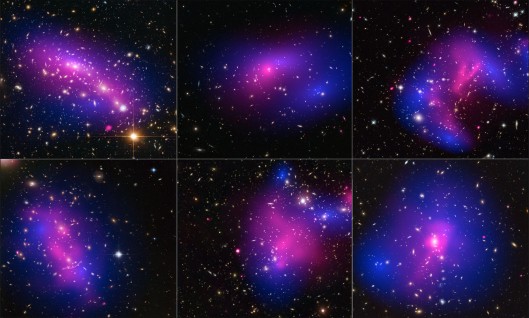Dark matter 'can't touch this' or even itself, researchers find
By Eric Mack
March 30, 2015

Galaxy cluster MACS J0416.1–2403 with dark matter map (Image: NASA/ESA)
When we look out into the universe, we don't know what we're looking at for the most part. In fact, we can't even see most of what we're looking at – that's because the majority of the universe is made up of mysterious, practically invisible dark matter. But new observations from the Hubble Space Telescope and NASA's Chandra X-Ray Observatory have unraveled the mystery little bit, with the new revelations hinting that dark matter could actually be even darker than previously thought.
Dark matter is just what it sounds like: matter that does not emit, reflect or absorb light, so it is invisible. However, we know it is there because of its measurable gravitational effects on parts of the universe that we can see. As such, one of the best ways to study dark matter is to observe what happens when galaxies containing large amounts of the stuff collide with each other.
"We know how gas and stars react to these cosmic crashes and where they emerge from the wreckage. Comparing how dark matter behaves can help us to narrow down what it actually is," said David Harvey of the Swiss École Polytechnique Fédérale de Lausanne (EPFL), lead author of a new study that looked at 72 galactic collisions using Hubble and Chandra data.
During these violent events, the stars of the colliding galaxies do not slow down because they are actually far enough away from other stars to travel through the crash without their progress being impeded. The researchers found that dark matter also does not slow down as galaxies collide, but this is not because it is far away from other dark matter as with stars – dark matter is believed to be spread evenly through galaxy clusters, meaning that the particles would often get very close to each other.
The resulting conclusion is that in addition to not interacting with visible matter, dark matter also does not interact with other dark matter.

"A previous study had seen similar behavior in the Bullet Cluster," says team member Richard Massey of Durham University. "But it's difficult to interpret what you're seeing if you have just one example. Each collision takes hundreds of millions of years, so in a human lifetime we only get to see one freeze-frame from a single camera angle. Now that we have studied so many more collisions, we can start to piece together the full movie and better understand what is going on."
The latest results would seem to rule out the possibility that interactions with dark matter can create a strong frictional force. Next, the team plans to study whether or not a different type of interaction might make dark matter particles bounce off each other or cause dark matter blobs to change their shape.
One theory posits that dark matter might be made up of so-called "supersymmetric" particles – a new, unconfirmed and more massive particle that interacts only weakly with electrons, protons, neutrons and the other known particles of the Standard Model.
The research paper, entitled "The non-gravitational interactions of dark matter in colliding galaxy clusters," is in the latest installment of the journal Science.
Source: ESA
copyright © Gizmag 2003 - 2015